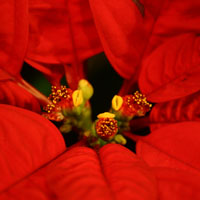
- African Violet
- Amaryllis
- Azalea
- Holiday Cactus
- Christmas Pepper
- Chrysanthemum
- Cyclamen
- Easter Lily
- Foliage Plants
- Forced Spring Bulbs
- Geranium
- Gloxinia
- Hydrangea
- Kalanchoe
- Orchids
- Poinsettia
Flowering and foliage plants can make welcome gifts. How long they remain attractive may be directly related to the care and handling they are given. This publication describes ways to properly care for holiday and gift plants to ensure maximum longevity.
Proper watering is critical. Large plants in small containers dry out quickly. Also, the relative humidity indoors tends to be quite low during the heating and air-conditioning seasons. Under these conditions, check plants daily. Over-watering can be just as detrimental as under-watering. Potted plants generally should not be watered until the soil is nearly dry to the touch. Then apply enough water that some drains from the bottom of the pot. The excess should be discarded.
Holiday and gift plants are often delivered in waterproof containers or wrapped in foil. If possible, remove these pot coverings or punch holes in the bottom of the pot to promote good drainage. Place the pot in a saucer to protect furniture. Misting plants is not advised and may cause increased foliar disease.
Supplying adequate light is also important for extending the life of holiday and gift plants. Place most potted plants where they will get high levels of indirect light. In the absence of natural light, most plants can be placed under lamps. Some plants, such as African violets and orchids, are grown successfully on artificially lighted shelves. Low light levels (150 foot candles or less) will hasten the decline of most indoor plants.
Normal household temperatures (60–75 °F) are satisfactory for most plants. Cooler temperatures (60–65 °F) lengthen the life of flowering plants, while extremely high temperatures (75–80 °F) will usually shorten the display life. This is particularly true of forced bulbs, which decline rapidly in the heat. Some foliage plants are subject to chilling injury below 55 °F. Avoid fast temperature changes by placing plants away from doors and heater and air conditioner vents.
Many flowering plants, even under the best conditions, last only a few weeks. You do not need to fertilize them. Plants kept for several months, though, do benefit from occasional fertilizing. Water-soluble or slow-release fertilizers are easiest to use. Follow label directions. Plants kept for a long time eventually outgrow their containers and need to be repotted. Prepared soil mixes are readily available. Choose a container, preferably one with drainage holes, proportional in size to the plant.
Below are a few common holiday and gift plants and tips on their care.
African Violet
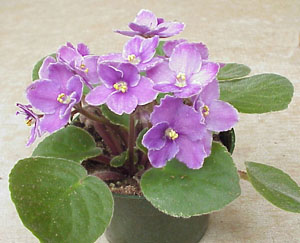
African violets are excellent indoor flowering plants. Available in many flower colors, they produce flowers year-round under the proper growing conditions. Individual flower clusters may last 3 to 6 weeks under good conditions. Poor flowering is often related to insufficient light. East- and west-facing windowsills are some of the best locations for violets.
African violets are highly subject to root and crown rot if over-watered. Use only warm water, as cold water causes spots on leaves. Buy only high-quality plants, because African violet pests and diseases spread very easily among other violets. Be especially watchful for crinkled tight crowns, a possible sign of incurable cyclamen mites. Mealy bugs can also infest African violets.
Amaryllis
Amaryllis are generally available from Christmas to Easter. These plants flower 4 to 6 weeks after bulbs are planted, with orange, red, white and pink varieties. Individual blooms may last 3 to 4 days. A flower stalk usually produces three or four large, trumpet-shaped blooms; large bulbs may produce more than one flower stalk.
To re-flower, place the plant in bright light (outdoors when temperatures permit). Allow the foliage to fully develop; fertilize and water throughout the summer months. In later summer or fall, as the leaves begin to die back, water less often. When the leaves have died completely, allow the soil to dry out and place the bulb in a cool, dry place for 4 to 8 weeks before resuming watering.
Azalea
Most azaleas bought from florists, supermarkets and other flower shops are special varieties developed for the greenhouse. If planted outdoors after use, they won't likely survive the winter. It's best to buy azaleas when flower buds are just starting to show color. Flowers will be fully opened in 1 to 3 days and provide 4 to 6 days of peak color. Medium light intensity and cool temperatures will make the flowers last longer. Don't let plants dry out. Azaleas may flower the next spring if left in the pot or placed in-ground outdoors until the plants get chilling but not freezing temperatures (32–45 °F).
Holiday Cactus
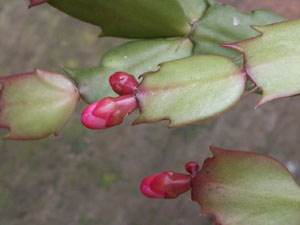
Three related plant species look like Christmas cacti. The three types bloom at different times of the year and can be found in flower at Thanksgiving, Christmas and Easter. All three require bright sunlight and moderate moisture levels. South-facing windows are excellent places for “holiday” cactus. After the 6 weeks of holiday blooming, remove spent flowers and apply a houseplant fertilizer. Plants can be grown outdoors in semi-shady places. Stem pieces of three segments or more are easily propagated. Holiday cacti should bloom about the same time every year.
Christmas Pepper
Plants are usually available in 4- and 6-in. pots during the fall and winter and are bought for their highly decorative fruit, which will be at peak color for 1 to 2 months. They will be brighter and last longer if you provide high light and mild temperatures (60–75 °F) and keep the soil moist. Fertilize weekly with a soluble fertilizer. Be aware that these peppers are sometimes extremely hot. Keep them away from small children. It is also very hard to re-bloom Christmas pepper. Frost will kill the plants.
Chrysanthemum
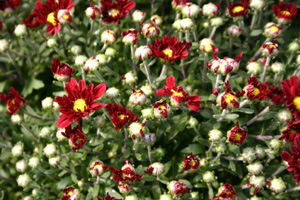
Two types of mums are sold at retail outlets: pot mums (killed by frost) and garden mums. Garden mums are generally available in the fall as a flowering pot plant. They can be planted outdoors and are hardy through the winter. Garden mums are perennials and will flower each year.
Pot mums are greenhouse varieties available year-round; they provide 3 to 4 weeks of enjoyment and should be discarded after flowering, as they are hard to re-flower. Buy pot mums when flower buds show full color. Diffuse, bright light levels and temperatures of 60 to 70 °F will prolong peak bloom. Do not let the leaves wilt.
Cyclamen
Cyclamen are excellent gift plants that are usually available from October through March. White, pink, lavender, purple, red and bicolor varieties are available. The plant produces many flowers, remaining in flower 2 to 4 months with proper care. Cool indoor temperatures (50–60 °F) such as may be found at an east or north-facing window during the winter will make the flowers last longer. Careful watering is essential. Plants are easily damaged from over-watering or under-watering. After flowering has stopped, gradually water less often. After the leaves die, allow the tuberous stem to remain dry 6 weeks before re-watering. New foliage will appear after watering resumes, and bright light and cool temperatures may sometimes produce a plant that will re-flower.
Easter Lily
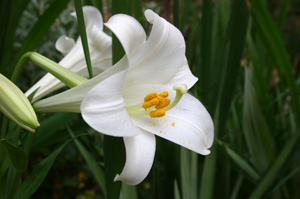
Easter lilies are produced specifically for the Easter season. Choose strong-stemmed plants with even, regular foliage and four to six or more flower buds. Cooler household temperatures (60 °F) prolong flowering. Remove yellow stamens before the pollen is shed to make the flowers last longer and keep the pollen from staining clothing, etc. Easter lilies can be transplanted outdoors in most areas in Georgia and will often re-bloom the following June. It's hard to re-flower bulbs kept in pots.
Foliage Plants
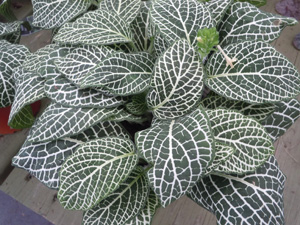
Foliage plants have varying light, temperature and watering requirements. For example, Chinese evergreens do well in very low light, whereas Dieffenbachia require medium to low light. Most can be damaged by temperatures below 55 °F. Ideal temperature for growth is 75–90 °F. Ask your county Extension agent or nursery owner or consult a plant book for the recommended light level for specific plants. If you keep plants several months, fertilize them every 2 months. To avoid salt buildup in the soil, allow generous amounts of water to run through the pot on a monthly basis.
From time to time, clean the leaves to remove dust. Foliage plants can be rejuvenated by placing them in a shaded area outdoors during warm weather. Avoid placing them near windows or doors during winter where there might be cold drafts.
Forced Spring Bulbs
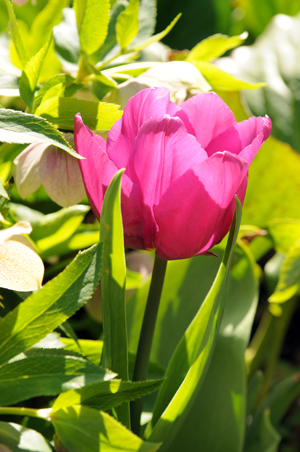
Forced bulbs include tulips, daffodils, crocuses and hyacinths that are exposed to chilling temperatures in a cooler or refrigerator for several weeks and then placed in warm greenhouses for the flowers to develop.
To get the most color and greatest longevity from your spring bulb, buy plants when the flower buds first show color. In most cases, the buds will open in 1 or 2 days. To slow down flower development and make the blooms last longer, keep plants cool. They will tolerate temperatures down to 40 °F. Keep plants well-watered; water stress can cut the flowering time in half. It's not necessary to fertilize, since the plants' useful life is 2 to 4 weeks. You may replant the bulbs outdoors, and they may re-flower after a year or two.
Geranium
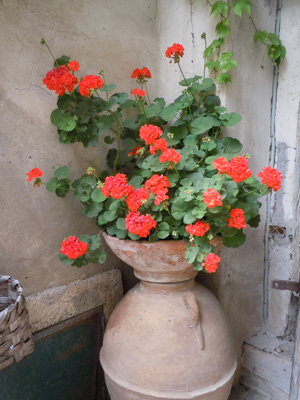
Potted geraniums are typically available from March through June. Many new types are available, including vining and hanging basket-grown varieties. Bright light is essential to keep geraniums in flower year-round. Keep them in pots or transplant them into the landscape once the danger of frost has passed. They are not winter hardy and must be brought inside before frost if you wish to keep them. Geraniums respond favorably to having the soil dry out between waterings.
Gloxinia
Gloxinias are very similar to African violets in the way you need to care for them. They may be available in florist shops year-round. Bright, indirect light is necessary to keep the plant in flower. Gloxinias typically flower over 2 to 4 weeks. Individual blooms last 4 to 6 days. Unlike African violets, gloxinias need to rest before re-flowering. When the leaves start to die back, begin watering less often. Allow the tuberous stem to rest 2 to 4 months in dry soil. To get the plant to re-flower (although it's hard to do), resume watering when new growth appears.
Hydrangea
Hydrangeas, generally recognized as outdoor flowering shrubs, are also available as 6- to 8-in. flowering potted plants. They are grown to flower for the spring holiday season. Blooms can last from 4 to 8 weeks if plants are bought as color first develops, watered adequately and kept at mild temperatures (65–75 °F) and medium light intensity. After the flowers fade, remove the flower heads and transplant the plants into the landscape.
Kalanchoe
Kalanchoes are available year-round in many colors. Flowers will last 3 to 6 weeks in mild temperatures (65–80 °F) and medium light, if the plants are kept watered. Using manufacturers' recommended levels of houseplant fertilizer once a month helps. The plants will re-bloom if you put them in artificial short days (long nights) for 6 to 8 weeks. They can be grown successfully if kept in sunny windows or placed outdoors in late spring.
Orchids
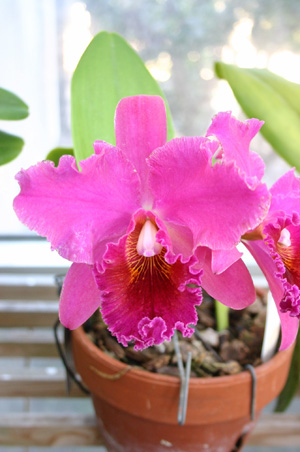
Orchids are easily cared for if kept away from intense light and cold. They do very well under fluorescent lights or near south-facing windows. Most orchids bloom only once a year, but the blooms can last as long as 2 months. Fertilize only when new leaves appear. Water often but allow the bark medium to dry out thoroughly between waterings. Orchids can be grown outdoors under the shade of trees after the danger of frost has passed.
Poinsettia
The colorful bracts of poinsettias may stay bright for months if you care for them properly. Bright, indirect light and frequent watering are essential. Don't allow the plants to wilt, but watering too often can damage roots.
Plants can be re-flowered, although the procedure is somewhat demanding. To re-flower, keep the plant indoors until the danger of frost has passed, then move it outdoors. Remove the bracts when they wither and discolor. Keep the plant in high indirect light (morning sun/afternoon shade). Water and fertilize often. Shape the plant as desired; prune it or pinch it to encourage branching. Bring the plant back indoors when night temperatures start to fall below 60 degrees. Continue to fertilize and water. Starting October 1, give the plant 14 hours of continuous darkness daily until bract color is well developed (mid-November). This can be done by placing the plant in a closet or covering it with a cardboard box. Any light during the dark period will delay or inhibit flowering. Night temperatures at this time should be between 60 and 70 °F. During the remaining 10 hours each day, give the plant maximum light.
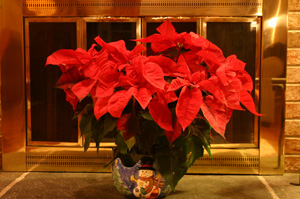
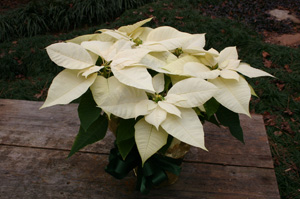
Status and Revision History
Published on Apr 02, 1992
In Review on Feb 24, 2009
Published with Full Review on Feb 11, 2014
Published with Full Review on Dec 08, 2020
Published with Full Review on Jul 07, 2022


























































